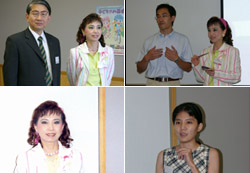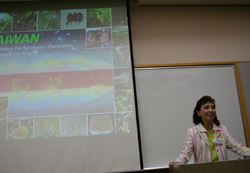9月24日,為做好下午2點即將展開研討會之事前準備,當天的午餐特別提早至11時於品川王子飯店內享用道地的壽喜燒宴,以便有更充裕的時間至會場布置準備。
In order to make the best preparation for the seminar at 2:00 pm, we had sushiyaki for lunch at 11:00 in the Shinagawa Prince Hotel on September 24 in order to save more time to decorate the venue.

下午2點不到,學員們陸續魚貫進入會場。本次實際參與的學員總共來自7個國家,包括:古巴、哥倫比亞、阿根廷、印尼、中國大陸、印度及台灣等。研討會在團長助理陳秋玉小姐帶動的自我介紹遊戲中揭開序幕,接著由主席黃晉英秘書長帶領林得恩先生、羅陽青先生、蔡坤憲先生及鍾政勳先生展開專題演說,首先由黃晉英秘書長演講「Symbiotic Civilization」:「首先我要提出一個永續建築(SB)的重要公式,此在2002年9月25日挪威奧斯陸舉辦的永續建築國際會議,其中特闢的特別會議中,我代表祐生研究基金會以『永續發展新模式-亞熱帶永續發展的挑戰』為題發表演說。在1970年代以前,一般認為地球的資源浩瀚,永續發展被視為理所當然。而西方先進國利用資源早就發展出共同的模式,簡單的說,就是工業化與都市化。在工業化部分藉著跨國貿易互通有無,循著比較利益發展出各自的特色,但都市化部分藉著工業製品的流通逐漸堆砌出雷同的都市文明。由於西方世界過去的成功發展,讓許多後進國競相學習模仿,除羨慕西方先進國因工業化與都市化造成生活的便利與豐盛外,希望藉著工業化與國際分工,透過國際貿易讓各種先進物資進入到他們的生活。在這樣的市場機制下,後進國漸漸發展出與西方世界雷同的都市風貌。由於價值觀、文化形式受到同化,使建築物與當地的氣候、地理條件是否吻合,很少受到關注。一直到能源危機之後,由於能源的緊縮,才發現全世界都市化地區的主要建築物,在國際貿易下,受到主流西方文明的影響早已呈現同質化,對在地適應上卻產生明顯的不適性,建築非但沒有真正有效的解決居住的問題,反而造成資源變相的浪費與破壞,如能源虛耗、建材誤用等。當天會議包括來自日本的 Professor Kazuo Iwamura,提出『日本共生建築理論與實務之變遷』;來自新加坡的 Professor William Lim,提出『反思西方高科技的發展對東亞地區社會、環境、空間公平性之密切的關聯性』;以及來自香港的 Professor Wan-Ki Chow,提出『對環境親善的建築特色』;大家都同意西方文明的方式對非溫、寒帶的亞熱帶地區並非最佳化,自然造成亞熱帶地區能源的虛耗與能源誤用的盲點,台灣亦然!盲目追隨不同地理氣候區塊的文明是不正確的,必要展開與自身所處的地理氣候區環境對話,藉知識、科技的累積,重新調適在地建築與聚落形式,才能發展出最佳化的模式,做為減輕環境負荷與去除資源、能源的緊張根本手段。我們越來越明瞭人類發展與環境保育間應取法生物間常見的『共生關係』,建構一個高效率的共生循環系統,來減輕生活起居對環境所形成的負荷,這是一種對策,我們稱它為『共生化』,也就是藉著生物學上的互利共生將我們食用的食物,尤其是綠色的蔬果,藉助建築構造使它跟起居者緊密結合,讓我們的Output成為植物的Input,植物的Output變成我們的Input,希望隨著循環效率的提升,從而收斂生活起居行為對外部的負荷。同時,也希望綠色植物的蒸散作用,能讓高溫在建築物的外牆得以下降。構造上取法亞熱帶原住民及古羅馬人控制溫溼度的智慧,企圖將生物界常見的共生關係成為我們與環境對話的新關係。而綠建築結合共生化對策更將是未來通往永續建築的良方。揭露一個永續建築的公式,那就是GB+Symbiosis=SB,亦即為綠建築+共生化=永續建築。同時也提出三個重要結論如下:
一、在地化:建築構造必要有能力回應當地的環境與氣候,同時也要維持起居者的舒適與健康。
二、團隊精神:永續是複合的議題,必要以多層次、多面向的團隊合作,才有可能提出周全的解決方案,同時持續的實驗、精進、執行、反饋,才能真正與環境對話。
三、共生化:『共生化』是一種法自然的小共生模式,人類要與綠色蔬果為主的生物建立更緊密的共生關係,才能不破壞自然,讓自然環境可以永續。
Students entered the venue one after another before 2:00 pm. These students were from 7 countries, including Cuba, Colombia, Argentina, Indonesia, China, India and Taiwan. The seminar began with the self-introduction led by Miss Chen Chiu-yu, assistant to the head of the delegation. Then, Secretary General Huang Chin-ying led Mr. Lin De-en, Mr. Luo Yang-ching, Mr. Tsai Kun-hsien and Mr. Chung Cheng-hsin to start the keynote speech. Secretary General Huang Chin-ying took the lead with "Symbiotic Civilization" : "First of all, I would like to introduce an important formula for sustainable building (SB). This formula was the topic of the speech on
New Sustainable Approach-Challenge of Subtropical Region. I gave at the special session of SB2002 Olso on behalf of the Archilife Research Foundation on September 25, 2002. Before the 1970s, people believed that there were rich resources on the earth and took sustainable development for granted. Similar models have long been developed by western countries according to the earth resources. Simply speaking, it was industrialization and urbanization. In industrialization, multinational trade was applied to exchange what one country has with what it hasn't, and countries in the world thus developed individual characteristics according to their comparative interests. However, due to the circulation of industrial products, similar urban civilizations were built across the world. The success of those advanced countries became the model of latecomer countries. Besides envying the convenient and rich lifestyles that brought industrialization and urbanization in western countries, latecomer countries wished to introduce various advanced materials into their everyday lives through industrialization, international division of labor, and international trade. With such a market mechanism, latecomer countries gradually developed urban areas in appearances similar to those of advanced countries. Following the assimilation of value and culture, whether or not buildings matched the local climate and geographical conditions was less of a concern. It was not until the oil crisis that people finally realized that major buildings in urban areas in different parts of the world long become homogeneous with the Western civilization due to international trade. Even worse, such homogeneity appeared to be so unsuitable for local conditions. In reality, instead of solving the heart of the living problems, these buildings have caused a waste and damage to resources, including energy consumption and material misuse. Speakers at the meeting agreed that Western civilization was not ideal for the subtropics, except for the cool and cold temperate regions. These speakers included Professor Kazuo Iwamura from Japan proposed
"Movements of the Environmentally Symbiotic Housing - Theory and practices in Japan", Professor William Lim from Singapore proposed
"Sustainable Environment for Whom - with special reference to cities in East Asia region" , and Professor Wan-ki Chow from Hong Kong proposed
"Architectural Features for the Environmental Friendly Century". This has consequently caused the black-spot of energy consumption and material misuse in the subtropics, including Taiwan! It is wrong to model thecivilization of different geographical and climatic regions without adjustment. It is necessary to dialogue with the geographical and climatic regions where one lives, so that we can readjust the local form of architecture and settlement and develop the best practice through the accumulation of knowledge and technology as radical means to reduce the load of the environment and to eliminate the stress of resources and energy. It is becoming more obvious that we must adopt a
symbiotic way to maintain a balance between human development and environmental preservation, and construct an efficient symbiotic circulation system to reduce the load on the environment from our everyday lives. We call this solution
Symbiosis. That is to say, by making use of the reciprocity of co-existence in biology, we combine the foods we consume, green vegetables and fruits in particular, to everyday life with architecture in order to turn human outputs into plant inputs, and vice versa. This is an attempt to reduce the environmental load that is brought by everyday life by enhancing the circulation efficiency. Secondly, we also hope that the evaporation effect of green plants can help to reduce the high temperature on the outside walls of buildings. In terms of structure, we model the temperature and humidity control of indigenous people of the subtropics and the Romans, in an attempt to turn the common symbiotic relations in the biological world into the new relationship of our dialogue with the environment. In this case, green building and symbiosis will be the best practice toward sustainable building as revealed in our new formula: GB +Symbiosis = SB; i.e. Green Building + Symbiosis = Sustainable Building. Under this premises, we can draw up the following three major conclusions:
1. Localization: Buildings should have the ability to respond to its local environment and climate, while also providing for the comfort and health of its inhabitants.
2. Team Work: Sustainability is a complex issue. It needs to be discussed on many different levels and aspects in order to come up with a comprehensive solution. Moreover, real dialogue with our environment will require continued experimentation, refinement, implementation and feedback.
3. Symbiosis: Symbiosis is a micro-scale symbiotic approach with mimicry of nature. It requires that people establish an intimate symbiotic relationship with the biological world, and particularly with the vegetables and fruits. It is in order to minimize their impact on nature and ensure environmental sustainability.

藉此次SB05Tokyo的國際會議,將過去3年所得到的一些經驗與大家分享,期盼可以提供大家一個新思維的起點,參照各位所處的環境以及現時的條件,提出屬於你們的永續建築。今天將介紹4種實用的工具,協助各位利用屬於你們自己所處環境內可以支持的共生化(Symbiosis),並且參照先進國家的綠建築(GB),完成你們國家的永續建築(SB)。為了協助你們想像與理解,我將以過去我們在台灣3年實驗的經驗,簡單地先做概略的描述,以便各位可以循此理論去思索永續建築對應的模式。永續建築其實就是綠建築再加入共生的概念,也就是師法自然與自然共生,在東方的古老的哲學思想中,最崇尚自然的莫過於道家思想,我們若以實體與虛體來比喻共生建築(實體)與共生生活(虛體),兩者共同之特點在於皆須對應物理環境條件,虛和實要能完美和諧的搭配。就綠建築而言,本身應採取最有效率的構造體,在構造體的四週架設植栽塔,形成一個綠色帷幕。依據日光作息的生活模式,應用共生化的理論,使生活所需可以循環使用,利用陽光達到自給自足的生活模式,並藉由數位化完成精神創發,達到心理的幸福感。這樣的新生活方式要有四個單位來操作循環運作,它包括植栽塔、核酸餐、潔淨及堆肥四個部分。在有陽光照射的建築物牆面外建構可迴轉的植栽塔,以便省力地生產新鮮蔬菜,原則上以原生種為主,其間可混種一般栽培種,以減少蟲害。當蔬菜生長茂密時,就提供了一個綠色帷幕,使空氣產生冷降,除減少日照外,也可以減輕空調負荷,有了大量的新鮮蔬菜加上一些優良蛋白質-細胞核多的肉類,如魚肉,就是最好的核酸餐食譜,可以提供健康的飲食。在生活中使用的廢棄物、水,經潔淨後,進入再循環系統,包括乾式馬桶、廢水處理等,為安全起見,乾式馬桶之堆肥需經二次堆肥或消毒後再與土壤混合提供養分,同時處理過的廢水也回到植栽塔,如此循環系統就完成封閉成為共生的循環。
Taking the opportunity of the SB05Tokyo, we wish to share with you some experiences we have accumulated over the past 3 years in order to introduce you to a new way of thinking and so to propose your own sustainable building according to the environment and current conditions of your countries. Today, we are going to present 4 practical tools that can help you to support symbiosis within your environment and to complete the SB of your countries according to the GB in advanced countries. To make it easier for you to imagine and understand, we will make a brief description of our practice in Taiwan over the past 3 years, so that you can follow our experience to develop the SB pattern corresponding to your countries. SB is in fact a concept combining GB and symbiosis, that is to say, it is to model nature and natural symbiosis. The Taoism is the school which advocates nature most among all different schools of oriental philosophy in the ancient time. If we compare symbiotic buildings (physical) and symbiotic lifestyles (virtual) with physicality and virtuality, we can see that response to the physical environment is the common feature in both cases. That is, something virtual must perfectly and harmoniously match with something physical. From the viewpoint of GB, the most efficient structure must be adopted by erecting vertical planting systems around the structure to form a green walling. Based on the life pattern of working in daytime and resting at night and by applying the theory of symbiosis, we can recycle daily necessities and accomplish a self-sufficient life pattern with sunlight. Also, we can use digitization to fulfill our spiritual creation in order to obtain the sense of happiness. It needs 4 components to operate and circulate such a lifestyle, including the vertical planting system, the nucleic acid diet, cleaning, and compost. Revolving vertical planting systems can be built outside walls with direct sunlight to grow fresh vegetable with lesser efforts. Basically, native species is preferable; and other plants can be grown to for pest control. When vegetable grows well, it becomes a green walling to cool down the air temperature. Besides reducing sun radiation, it can lower the workload of air-conditioners. With these vegetables and with some meat containing quality protein and more nuclei, such as fish, they are the best nucleic acid ingredients for healthy diets. After cleaning, wastes and wastewater in everyday lives can be put in the circulation system, including dry toilet and wastewater treatment. For the reason of safety, compost from the dry toilet must undergo secondary composting or disinfection before mixing with soil for nutrition. Likewise, wastewater after treatment will be used in the vertical planting system. In this way, the circulation system will become a closed symbiotic circulation.
我們相信只要具備這四大循環,就可以構成共生化(Symbiosis)的基本結構,相信隨著文明的累積,四大循環,可以負載更多的小循環或多重循環,完成永續概念下最需要的循環結構,也很容易從單體建築擴大到社會,甚至到國家層級,構成我們所謂的循環型社會,這樣才有可能真正減輕環境的負荷,讓人為的發展不致成為環境支撐不起的負擔。這個循環的基礎在於以「人」為中心,「人」與「綠色植物」構成共生循環的基礎。因為「綠色植物」利用陽光、空氣和水,才能構成我們賴以生存的條件,提供我們日常必須的食物。而與我們共生的「綠色植物」,早已存在我們環境之中,它跟環境中的土壤、微生物、昆蟲,本就形成自然共生的狀態,它們是相互拮抗而演化。因此,若能了解食物鏈在自然環境中的位置,我們才能有效利用它的共生機制。透過人為的措施,擴張它的生存質與量,來支持人類進一步的發展。所以一方面我們要呼籲保護自然環境,做為永續利用基礎,另外一方面,藉由了解選取人類生存發展所需要的物種,來協助人類進一步的成長,而達到永續的目的。因此,以下的四組報告是我們認為建構共生化(Symbiosis)的關鍵:分別由林得恩先生報告氣象調查;鍾政勳先生報告野菜調查;蔡坤憲先生報告節肢動物調查及羅陽青先生報告微生物調查。」
We believe that the circulation structure of symbiosis can be formed with these four components systems. We also believe that following the accumulation of civilizations, these four circulation systems can support more smaller-scaled circulation systems or multiple circulation systems, and ultimately the most important circulation structure for sustainable development. This also includes unit buildings to the society and even a country, and gradually the circulative society to which we refer. This will be the only way to truly reduce the environmental load and to prevent artificial development from causing unsupportable load to the environment. This circulation is human-centered and built up on the symbiosis between humans and green plants because the latter needs sunlight, air and water to provide us foods for survival. In fact, green plants that co-exist with us have long been in our environment. They form a natural symbiosis with soil, microorganisms and insects, and altogether they resist one another and evolve together. Therefore, we can only benefit from symbiosis not until we understand the position of food chain in nature. In doing so, we can expand the quality and quantity of its survival through human intervention to support further human development. On the one hand, therefore, we urge people to protect the environment as the foundation for sustainable use. On the other hand, by choosing the species needed for human survival and development, we can promote further human development for sustainability. Based on these reasons, we believe that following four reports will be the crux for constructing symbiosis. These include the meteorology report by Mr. Lin De-en, the report on wild edible plants by Mr. Chung Cheng-hsin, the report on insects by Mr. Tsai Kun-hsien, and the report on microorganisms by Mr. Luo Yang-ching."